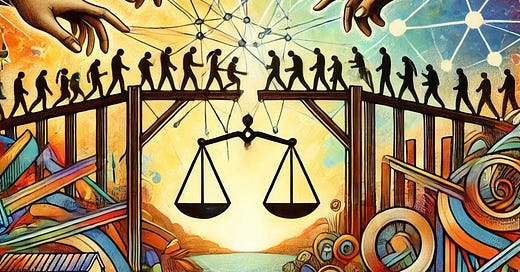Turning Intention into Action: Concrete Steps for Co-Creation and Liberation
Practical Steps for Dismantling Supremacy Culture and Building Equitable Communities
Introduction:
Welcome back to the Allyship Series. As we near the conclusion of this journey, I want to take a moment to thank each of you who have subscribed, shared, or engaged with these articles. Your contributions ensure that this work remains accessible to those who need it most. If financial barriers prevent you from accessing these resources, please email me at scholarships@desireebstephens.com—equity is at the heart of this work.
In a previous article, From Ally to Co-Creator: Shifting the Paradigm for True Liberation, we explored the critical shift from performative allyship to co-creation and mutual accountability. This work requires us to let go of seeking approval and focus on building equitable relationships rooted in love and accountability.
Today, we move from intention to action. In doing so, we must turn our attention to the "how." Action is where allyship fades away, and co-creation takes hold. It’s where intentions are transformed into tangible steps that support liberation, equity, and justice. This work isn’t easy, but it is necessary—and it is sacred. For white communities, this means taking tangible steps to dismantle systems of oppression and support liberation efforts, not as allies looking to save, but as co-creators committed to equity and justice.
Let’s dive into the practical, relational, and sacred work of co-creation.
The Gap Between Intention and Action
Many white-bodied people who wish to engage in “allyship” find themselves stuck in the gap between intention and action. This gap is often widened by fear—fear of making mistakes, fear of discomfort, or fear of losing power. Supremacy culture reinforces this gap, perpetuating patterns of fear, perfectionism, and defensiveness.
Here’s the truth: action doesn’t have to be grandiose to matter. It’s the small, consistent, and intentional steps that dismantle systems of harm. Co-creation isn’t about perfection or performance; it’s about showing up, learning, and staying engaged, even when it feels uncomfortable.
The Role of Supremacy Culture in Action
The 15 Pillars of Supremacy Culture often show up in ways that prevent white-bodied people from moving from intention to action. Here are some key pillars that specifically hinder meaningful allyship:
Sense of Urgency: The belief that change must happen immediately often leads to performative actions rather than sustainable, intentional efforts. This pillar encourages quick fixes that prioritize appearances over genuine transformation.
Perfectionism: Fear of making mistakes or being criticized can paralyze individuals, keeping them from taking any action at all. True allyship requires embracing imperfection and being willing to learn and grow through mistakes.
Individualism: The notion that individual efforts are enough, rather than recognizing the power of collective action, undermines the relational and communal nature of liberation work. Supremacy culture often discourages collaboration and mutual accountability, isolating efforts that could be more impactful if done collectively.
Right to Comfort: The desire to avoid discomfort or emotional labor can lead to inaction or shallow engagement. Allyship requires leaning into discomfort as a necessary part of growth and accountability.
Quantity Over Quality: The focus on doing "a lot" instead of doing meaningful, intentional work can dilute the impact of allyship efforts. Prioritizing depth and sustainability over performative busyness is essential.
Defensiveness: Fear of critique or being “called out” can prevent individuals from reflecting on their own biases and actions. Embracing feedback as a tool for growth rather than a personal attack is crucial for allyship.
By identifying and disrupting these patterns, white-bodied individuals can begin to align their actions with the values of liberation, equity, and justice. Understanding the role these pillars play helps move beyond the inertia of intention and into the transformative power of action.
Concrete Steps for Co-Creation and Liberation
1. Engage in Mutual Aid
Mutual aid is a foundational practice of liberation. It’s about redistributing resources and meeting community needs through collaboration and solidarity, rather than charity.
Action Step: Identify local mutual aid networks or grassroots organizations led by marginalized communities and offer your time, skills, or financial support.
Reflect: How can your contributions support community self-determination rather than perpetuating dependency or control?
Gain access to the full series on allyship and co-creation.
Receive exclusive content to deepen your liberation practice.
Support equity by making this work accessible to all.
If financial barriers prevent you from subscribing, email scholarships@desireebstephens.com to request access.




